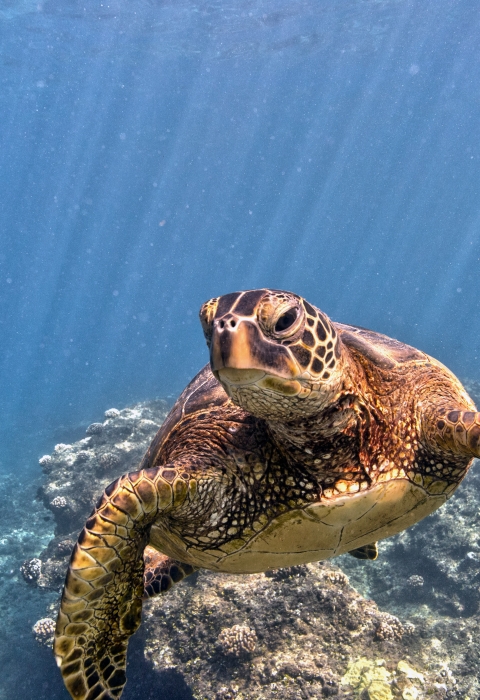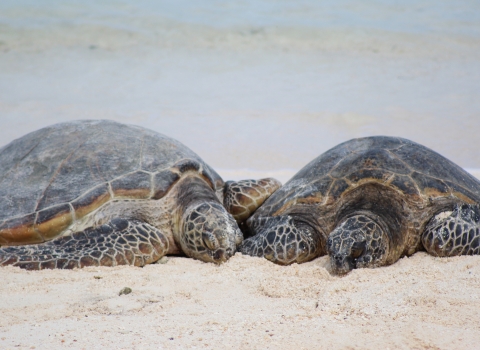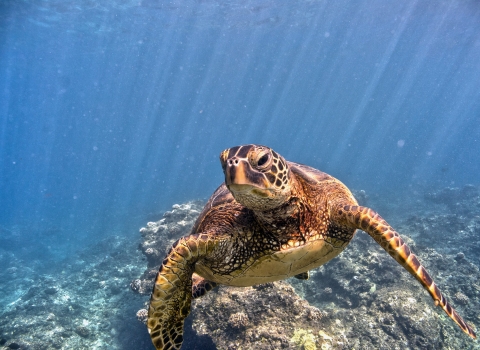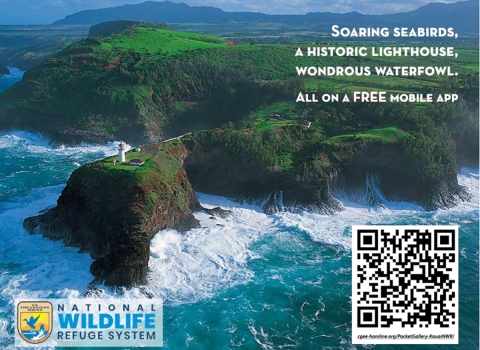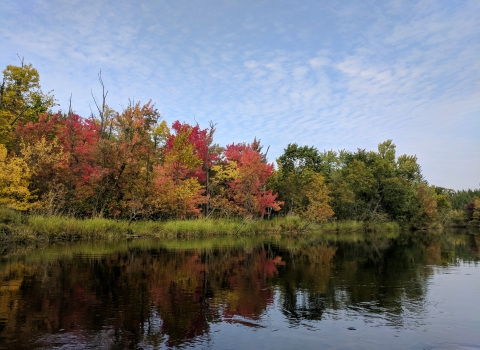Q: What action is being taken?
A: The U.S. Fish and Wildlife Service and National Oceanic and Atmospheric Administration (NOAA) Fisheries propose designating critical habitat to protect and recover the green sea turtle (Chelonia mydas) under the Endangered Species Act. The agencies share jurisdiction of the species protection and recovery with the Service overseeing their protection on land and NOAA Fisheries overseeing their protection in the marine environment.
The largest of the hard-shelled sea turtles, green sea turtles were first listed under the ESA in 1978. Reaching up to 4 feet long and weighing as much as 400 pounds, they can live to be 100 years old.
Q: Why is critical habitat being designated for the green sea turtle?
A: Following a status review of the green sea turtle, a final rule listing 11 distinct population segments was issued in 2016: three DPSs are endangered and eight DPSs are threatened. The 2016 rule did not include the proposed critical habitat, as critical habitat was deemed not determinable at that time. The Fish and Wildlife Service and NOAA Fisheries were sued on that decision, and on Aug. 21, 2020, the parties entered into a stipulated settlement agreement that the agencies would submit a proposed critical habitat determination for the six DPSs at issue in the complaint on or before June 30, 2023. Only five of these six DPSs have terrestrial critical habitat proposed for designation, whereas all six have marine critical habitat proposed for designation.
Q: Why are green sea turtles listed under the ESA?
A: Historically, green sea turtles were killed for their meat and eggs, leading to global population declines. Today, the species faces an array of risks, including threats to its habitat. Coastal development impacts the beaches they need to nest and increases artificial lighting, causing hatchlings to migrate toward the lights and away from the ocean. Runoff and other pollution kill seagrass and algae, reducing the availability of these major food sources for green sea turtles. Dredging impacts these food resources and disturbs the rocks, reefs, and troughs where green turtles rest and may result in the direct take of the species. In-water construction may also block migration or access to nesting beaches.
Climate change also imperils green sea turtles as rising seas and storms erode beaches and flood nests, causing them to wash away. Higher sand temperatures can increase the number of female hatchlings, shifting the ratio of males and females. Changes in ocean temperature alter the amount and distribution of food, upsetting their migration, foraging range, and nesting seasons.
Q: What is a critical habitat?
A: Critical habitat includes geographic areas containing features essential for the conservation of a listed species that may require special management considerations or protection. Federal agencies are required to consult with the Fish and Wildlife Service and NOAA Fisheries if actions they authorize, fund, or carry out may affect critical habitat. Federal agencies are also required to ensure actions they authorize, fund, or carry out do not destroy or adversely modify critical habitat.
Specifying the location of habitat essential for the conservation of the species helps federal agencies identify where to use their authorities to benefit listed species. The designation also helps focus the conservation efforts of other conservation partners, such as state and local governments, non-governmental agencies, and individuals.
https://www.fws.gov/project/critical-habitat
https://www.fisheries.noaa.gov/national/endangered-species-conservation/critical-habitat
Q: What areas are proposed for critical habitat designation for green sea turtles?
Proposed Terrestrial Critical Habitat
The Service proposes designating 8,870 acres (35.9 square kilometers) of critical habitat on land for five distinct population segments where green sea turtles bask, nest, incubate, hatch, and travel to the sea. This proposed designation includes 101 units in the following DPSs:
North Atlantic DPS (Threatened)—5,725 acres (23.2 square kilometers) and 23 units in the State of Florida (Brevard, Broward, Charlotte, Escambia, Flagler, Franklin, Gulf, Indian River, Lee, Martin, Monroe, Palm Beach, Sarasota, St. Johns, St. Lucie, Volusia, and Walton Counties); 249 acres (1 square kilometer) and 10 units in Puerto Rico (within the municipalities of Guayama and Maunabo, Mona Island, and Vieques Island).
South Atlantic DPS (Threatened)—117 acres (0.5 square kilometers) and 8 units on the island of St. Croix in the U.S. Virgin Islands.
Central North Pacific DPS (Threatened)—1,183 acres (4.8 square kilometers) and 23 units in the State of Hawaiʻi (the main Hawaiian Islands including Hawaiʻi, Honolulu, Kauaʻi, Maui, and Kalawao Counties); and 1,050 acres (4.2 square kilometers) in eight units in the Northwestern Hawaiian Islands (Kure Atoll, Midway Atoll, Pearl and Hermes Atoll, Laysan Island, Lisianski Island, and French Frigate Shoals).
Central South Pacific DPS (Endangered)—220 acres (0.9 square kilometers) and five units in the territory of American Samoa (Aunuʻu Island, Ofu and Olosega Islands, Taʻu Island, Rose Atoll, and Swains Island Atoll); and 22 acres (0.09 square kilometers) and one unit in the incorporated unorganized Territory of Palmyra Atoll.
Central West Pacific DPS (Endangered)—125 acres (0.5 square kilometers) and 14 units in the territory of Guam; and 180 acres (0.7 square kilometers) and nine units in the Commonwealth of the Northern Mariana Islands.
These units represent an approximate mix of 24% federal ownership; 26% state, territory, or commonwealth ownership; 8% local government ownership (municipal, county); 33% private/other ownership (private, non-governmental conservation); and 9% uncategorized (undetermined ownership). These percentages vary among the DPSs.
Approximately 60% of the proposed designation overlaps existing critical habitat designated for other federally threatened or endangered species that inhabit coastal beach habitat, including 10 species in the North Atlantic DPS, two species in the South Atlantic DPS, 35 species in the Central North Pacific DPS, and three species in the Central West Pacific DPS; there is no existing designated critical habitat that overlaps green turtle proposed units within the Central South Pacific DPS.
For a detailed list of counties, estimated shoreline miles within each unit, maps, and other information, please see the proposed rules available via the Federal eRulemaking Portal at http://www.regulations.gov/.
Proposed Marine Critical Habitat
NOAA Fisheries proposes to designate marine critical habitat to support the reproduction, migration, foraging, and resting of green sea turtles at all life stages.
- North Atlantic DPS (threatened) — Sargassum habitat from 10 meters depth to the US EEZ in the Gulf of Mexico and Atlantic, most of which overlaps with existing loggerhead sea turtle critical habitat; nearshore waters from the mean high water line to 20 meters depth in the States of Florida, Texas (from the Mexico border to and including Galveston Bay), North Carolina (from the South Carolina border to, but not including Albemarle and Currituck Sounds) and the Commonwealth of Puerto Rico (Guayama and Maunabo, southern Mona Island, eastern and southern Vieques Island, Culebra Island, and the northern coast of Puerto Rico Island including Punta Salinas, Escambron, and Arrecifes Isla Verde Natural Reserve).
- South Atlantic DPS (threatened) — nearshore waters from the mean high water line to 20 meters depth in the U.S. Virgin Islands.
- East Pacific DPS (threatened) — nearshore waters from the mean high water line to 20 meters depth in California, from, and including San Diego Bay to and including Santa Monica Bay (except for the area between Oceanside and San Onofre, where no data were available) and surrounding Catalina Island; nearshore waters from the mean high water line to 10 kilometers offshore of the Mexico border to and including North San Diego Bay.
- Central North Pacific DPS (threatened) — nearshore waters from the mean high water line to 20 m depth in the Hawaiian Archipelago including Hawai‘i, Maui, Lana‘i, Moloka‘i, Kaho‘olawe, O‘ahu, Kaua‘i, Lalo/French Frigate Shoals, Kamole/Laysan Island, Kapou/Lisianski Island, Manawai/Pearl & Hermes Atoll, Kuaihelani/Midway Atoll, Kuaihelani/Midway Atoll, and Hōlanikū/Kure Atoll.
- Central South Pacific DPS (endangered) — nearshore waters from the mean high water line to 20 meters depth in American Samoa (Tutuila Island, Aunuʻu Island, reproductive areas of Ofu and Olosega Islands, Taʻu Island, Rose Atoll, and Swains Island Atoll); nearshore waters from the mean high water line to 20 meters depth in the Pacific Remote Island Areas of Palmyra Atoll, Jarvis Island, Baker Island, and Howland Island.
- Central West Pacific DPS (endangered) — nearshore waters from the mean high water line to 20 meters depth in Guam and the Commonwealth of the Northern Mariana Islands (Saipan, Tinian, Rota, Aguijan, Pagan, Alamagan, and Sarigan, and the reproductive area of Agrihan).
Q: What features are essential to the conservation of the green sea turtle and contained in the proposed terrestrial critical habitat areas?
A: The key features important to the conservation of the green sea turtle are extra-tidal or dry, sandy beaches from the mean high-water line to the toe of the secondary dune for areas with dunes or up to 15 meters (50 feet) inland for flat beaches, with relatively unimpeded ocean access for turtles to nest and substrate features that support egg incubation and allow for hatchlings to emerge from the sand and return to the sea. Sufficient darkness is important to ensure that nesting turtles are not deterred from emerging onto beaches, and hatchlings and post-nesting females can orient to the sea. Areas within the Central North Pacific DPS are also required with gradually sloping beaches and appropriate habitat with relatively unimpeded ocean access for basking activity.
Q: What features are essential to the conservation of the green sea turtle and contained in the proposed marine critical habitat areas?
A:
- Reproductive (North Atlantic, South Atlantic, Central North Pacific, Central South Pacific, and Central West Pacific DPSs): From the mean high-water line to 20 meters depth, sufficiently dark and unobstructed nearshore waters adjacent to nesting beaches proposed as critical habitat by the Service, to allow for the transit, mating, and inter-nesting of reproductive individuals and the transit of post-hatchlings.
- Migratory (North Atlantic and East Pacific DPSs): From the mean high-water line to 20 meters depth (North Atlantic DPS) or 10 km offshore (East Pacific DPS), sufficiently unobstructed waters that allow for unrestricted transit of reproductive individuals between benthic foraging/resting and reproductive areas.
- Benthic foraging/resting (North Atlantic, South Atlantic, East Pacific, Central North Pacific, Central South Pacific, and Central West Pacific DPSs): From the mean high-water line to 20 meters depth, underwater refugia and food resources (i.e., seagrasses, macroalgae, and/or invertebrates) of sufficient condition, distribution, diversity, abundance, and density necessary to support survival, development, growth, and/or reproduction.
- Surface-pelagic foraging/resting (North Atlantic DPS): Convergence zones, frontal zones, surface-water downwelling areas, the margins of major boundary currents, and other areas that result in concentrated components of the Sargassum-dominated drift community, as well as the currents which carry turtles to Sargassum-dominated drift communities, which provide sufficient food resources and refugia to support the survival, growth, and development of post-hatchlings and surface-pelagic juveniles, and which are located in sufficient water depth (at least 10 meters) to ensure offshore transport via ocean currents to areas which meet forage and refugia requirements.
Q: How does critical habitat designation affect coastal landowners, the public, and other federal agencies?
A: Designating critical habitat does not affect private landowners unless they implement actions involving federal funds, permits, or activities. In those circumstances, it would be the federal agency’s responsibility to ensure those actions will not destroy or adversely modify the critical habitat. Critical habitat designation does not create a protected marine area, refuge, wilderness reserve, preservation, or other conservation areas. Once critical habitat is designated, federal agencies consult with the Service or NOAA Fisheries to ensure actions they fund, authorize, or undertake will not destroy or adversely modify the critical habitat.
Q: Are any lands being exempted or considered for exclusion from the proposed critical habitat designation?
A: The Service (terrestrial) is exempting 14 military installations or facilities, totaling approximately 3,312 acres (13.4 square kilometers), from critical habitat under section 4(a)(3) of the ESA and is considering excluding 139 acres (0.6 square kilometers) covering one permitted habitat conservation plan in Florida under section 4(b)(2).
Areas owned or controlled by the U.S. Department of Defense are required under the Sikes Act to implement Integrated Natural Resources Management Plans and are exempt from critical habitat designations if the Service determines such a plan provides a benefit to the species for which critical habitat is proposed for designation.
NOAA Fisheries is working with the U.S. Department of Defense to identify potential exemptions. NOAA Fisheries is proposing to exclude approximately 108,965 square kilometers from the marine critical habitat designation because the economic impacts outweigh the benefits of including those areas in the designation.
Q: Can comments or information be provided on the critical habitat proposal?
A: The Service and NOAA Fisheries are seeking information and comments from the public, government agencies (including territories and commonwealths), Native American Tribes, Indigenous communities, the scientific community, and industries on the proposed critical habitat designations. The analyses supporting critical habitat designations are based on the best scientific and commercial data available and undergo independent peer review. Comments simply offering support for or opposition to the proposed rules, while noted, are not used in determining the final actions.
A list of the specific types of information and comments being sought is provided in the “Information Requested” section of the proposed rules available in the Federal eRulemaking Portal at http://www.regulations.gov/.
Q: How can comments or information be submitted?
A: Comments on proposed terrestrial and marine critical habitat must be made separately for each rule and received by 11:59 p.m. Eastern time on Oct. 17, 2023.
Comment on Proposed Terrestrial Critical Habitat
Visit the Federal eRulemaking Portal and in the search box enter FWS-R4-ES-2022-0164, which is the docket number for this rulemaking. By hard copy, submit by U.S. mail or hand-delivery to Public Comments Processing, Attn: FWS-R4-ES-2022-0164, U.S. Fish and Wildlife Service, MS: PRB/3W, 5275 Leesburg Pike, Falls Church, VA 22041–3803.
Comment on Proposed Marine Critical Habitat
Visit the Federal eRulemaking Portal and in the search box enter NOAA-NMFS-2023-0087, which is the docket number for this rulemaking. By hard copy, submit by U.S. mail or hand-delivery to: Endangered Species Division, Office of Protected Resources, National Marine Fisheries Service, 1315 East West Highway (SSMC3), Silver Spring, Maryland 20910, Attn: Green Turtle Critical Habitat Proposed Rule.
Comments will be posted on http://www.regulations.gov.
Public Meetings and Hearings
The Service and NOAA Fisheries will conduct virtual and in-person informational meetings and public hearings on the proposed critical habitat. Registration is only required for virtual meetings. Information about the in-person meetings and registration for the virtual meetings can be found here.
Q: Are comments and information considered in making the final decision?
A: Yes. All comments and information are reviewed and given appropriate consideration as the Service and NOAA Fisheries’ staff work through the final decision-making processes. Stakeholders and the general public play an important role in helping ensure final actions are based on the best scientific and commercial information available.
Q: Are the possible economic impacts considered in the proposed designation of critical habitat on coastal communities and landowners?
A: Yes. The Service and NOAA Fisheries have prepared draft economic analyses of the proposed critical habitat that will be released for public review and comment concurrent with the proposed rules. These can be found at http://www.regulations.gov as supporting documents for each activity under the appropriate docket numbers.
Q: Where can more information on green sea turtles be found?
A: Visit the Service and NOAA Fisheries websites for more information about the green sea turtle.
